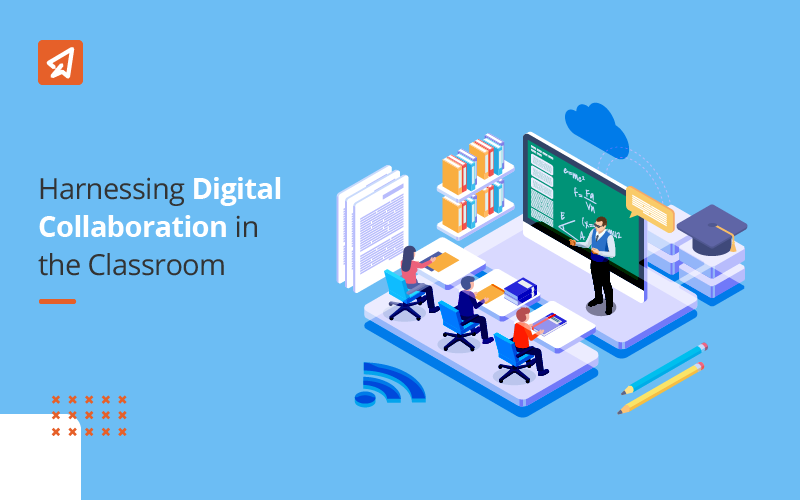Harnessing Digital Collaboration in the Classroom

In an era defined by technological advancements and rapid digitalisation, the education landscape in India has witnessed a remarkable transformation. One of the most profound shifts in recent years is the integration of digital collaboration tools within the classroom environment is turning them into smart classrooms. This educational revolution has been spurred by the increasing need to prepare Indian students for a digitally-driven world, where effective teamwork and remote collaboration are not just valuable skills but essential ones. To address this, schools are adopting smart classrooms — an environment furnished with digital collaboration tools to promote learning and increase student engagement in greater numbers to meet this requirement.
According to a 2020 report by the Ministry of Education in India, a staggering 85% of K-12 teachers across the country have adopted digital collaboration platforms to facilitate learning and enhance student engagement. This surge in adoption reflects the growing recognition of digital collaboration in the classroom as a game-changer in Indian education, with its roots deeply intertwined with the demands of the 21st century.
As we delve deeper into the digital age, the statistics surrounding this trend in India become even more compelling. In a study conducted by a leading Indian educational research institute, it was revealed that 82% of students believed that digital collaboration tools improved their ability to work on group projects effectively. Additionally, 68% of educators reported witnessing a notable increase in student engagement when utilising collaborative teaching methods. This data underscores the transformative power of digital collaboration in classrooms, not only in terms of boosting academic outcomes but also in fostering the collaborative and problem-solving skills vital for success in the modern world.
What is Digital Collaboration in the Classroom?
Digital collaboration in the classroom refers to the use of technology and online tools to facilitate teamwork, communication, and information sharing among students and educators. This approach goes beyond traditional methods of classroom interaction and opens up a world of possibilities for collaborative learning experiences.
Key Elements of Digital Collaboration in Classroom:
- Online Platforms: Digital collaboration typically occurs on dedicated online platforms or through software applications designed for educational purposes. These platforms enable students and teachers to interact, share resources, and collaborate on projects seamlessly.
- Real-Time Communication: One of the key features of digital collaboration is real-time communication. Students can engage in discussions, ask questions, and seek clarification instantly, fostering a more dynamic learning environment.
- Remote Access: Digital collaboration isn’t limited by physical boundaries. Students and educators can participate from anywhere with an internet connection, making it particularly valuable for remote or distance learning scenarios.
- Shared Resources: These platforms often provide tools for sharing documents, videos, presentations, and other educational materials. This enables students to access and collaborate on course materials efficiently.
- Collaborative Projects: Digital collaboration encourages students to work together on projects, assignments, and group activities. It promotes teamwork, problem-solving, and critical thinking skills.
Examples of Classroom Collaboration Tools:
- Online Discussion Forums: Platforms like Moodle, Google Classroom, or Edmodo provide spaces for students and teachers to engage in threaded discussions, share ideas, and ask questions.
- Collaborative Document Editing: Tools such as Google Docs and Microsoft 365 allow multiple users to edit a document simultaneously, making group projects more efficient.
- Virtual Learning Environments: Learning management systems like Blackboard or Canvas offer a comprehensive suite of tools for managing courses, assignments, and student interactions.
- Video Conferencing: Apps like Zoom and Microsoft Teams facilitate virtual classrooms, enabling live lectures and face-to-face interactions, even in remote learning scenarios.
Transform Your Classroom into a Smart Collaborative Hub with Extramarks Smart Class Plus.
Learn More2 Aspects of Digital Collaboration in K-12 Education
Collaborative Learning & Collaborative Teaching
What is Collaborative Learning?
Collaborative learning is an educational approach that emphasises active participation and interaction among students. In a collaborative learning environment, students work together on projects, assignments, and group activities, pooling their knowledge and resources to achieve common learning goals. It goes beyond the traditional model of solitary learning and encourages students to engage in discussions, share ideas, and collaborate on tasks. Collaborative learning fosters teamwork, critical thinking, communication skills, and a deeper understanding of the subject matter. It can be facilitated through various methods, including group discussions, peer teaching, and the use of digital collaboration tools.
What is Collaborative Teaching?
Collaborative teaching, on the other hand, refers to educators working together to plan, deliver, and assess instruction. This approach promotes synergy among teachers, allowing them to combine their expertise, ideas, and teaching strategies to create a more comprehensive and effective learning experience for students. Collaborative teaching can occur in various forms, such as co-teaching, where two or more teachers jointly lead a class, or through interdisciplinary collaboration, where educators from different subjects collaborate to integrate their curriculum and provide students with a holistic perspective. Collaborative teaching not only benefits students by offering diverse perspectives but also supports professional development among educators, enhancing their teaching skills and knowledge-sharing abilities.
Why Does Digital Collaboration in the Classroom Matter?
In this era of technology-driven education, fostering digital collaboration among students holds significant importance. It transcends the mere acquisition of knowledge; it transforms the learning experience into collaborative learning to make it an interactive and unforgettable journey. Furthermore, it helps students with:
- Skill Development and Enrichment: The world is rapidly digitising, and our classrooms are no exception. When students engage in online collaboration, they go beyond rote learning. It equips them with skills that will prove invaluable in their future endeavours. Online teamwork nurtures problem-solving, communication, and teamwork abilities.
- Digital Etiquette Mastery: Flourishing in the digital realm isn’t solely about mastering emojis and hashtags. Digital collaboration imparts vital lessons in online etiquette, delineating the dos and don’ts of navigating the virtual space. It’s akin to providing students with a handbook on becoming exemplary digital citizens—a crucial competency for the unfolding future.
- Fostering Unity: Digital collaboration isn’t synonymous with isolated efforts; it engenders a profound sense of unity among students. They discover the value of support, cooperation, and acceptance. It creates a digital camaraderie that nurtures a profound sense of belonging. Together, they can collectively attain shared objectives and aid one another’s growth. It’s a digital bond that transcends physical boundaries.

Encourage teamwork with collaborative classroom activities designed for smart classrooms. Download your free printable activity cards today!
Challenges of Digital Collaboration in the Classroom:
While digital collaboration in the classroom offers immense potential, it comes with its share of challenges that educators and students must navigate. These challenges encompass various aspects, from technological barriers and digital literacy disparities to concerns about security, engagement, and effective assessment. In this section, we’ll delve into these challenges and explore practical solutions to overcome them, ensuring that digital collaboration remains a valuable tool for enhancing the learning experience while addressing the obstacles that may arise along the way.
Technological Barriers:
Access to Technology: Not all students have equal access to digital devices and high-speed internet, creating a digital divide. This can lead to disparities in participation and engagement.
Solution: Schools can provide devices or offer technology lending programs to bridge the digital divide among students.
Technical Issues: Glitches, software malfunctions, or connectivity problems can disrupt the flow of digital collaboration, affecting the overall learning experience.
Solution: Encourage students to have backup devices and educate them on basic troubleshooting steps for common technical issues.
Digital Literacy:
Varied Skill Levels: Students and teachers may have different levels of digital literacy. Some may be comfortable with a range of digital tools, while others may struggle to adapt, impacting the effectiveness of collaborative efforts.
Solution: Offer digital literacy training or workshops for both students and teachers to ensure everyone can comfortably navigate digital tools.
Security and Privacy Concerns:
Data Security: Protecting sensitive student information is a priority. Collaborative platforms must adhere to strict security measures to ensure the privacy and integrity of student data.
Solution: Implement strict data encryption protocols and comply with data protection regulations.
Online Safety: Teachers need to educate students on responsible online behaviour and cybersecurity to minimise risks associated with digital collaboration.
Solution: Include digital citizenship and online safety lessons as part of the curriculum to educate students about responsible online behaviour.
Engagement and Participation:
Virtual Distractions: Students may face distractions such as social media or other non-educational websites during digital collaboration sessions, affecting their focus and participation.
Solution: Establish clear guidelines for online behaviour and utilise digital tools that allow for monitoring and engagement tracking.
Lack of Face-to-Face Interaction: Building relationships and a sense of community can be challenging in a digital environment where face-to-face interactions are limited.
Solution: Create opportunities for virtual team-building exercises and discussions to foster a sense of community.
Collaboration Management:
Coordination Challenges: Managing collaborative projects online can be complex, especially when coordinating tasks, deadlines, and contributions from multiple team members.
Solution: Use project management tools and shared calendars to facilitate task management and communication.
Accountability: Ensuring that each student contributes actively to collaborative tasks and projects can be difficult without a physical presence to monitor participation.
Solution: Assign roles and responsibilities within collaborative groups and employ peer assessment to ensure active participation.
Teacher Professional Development:
Training Needs: Educators may require ongoing training to stay updated on the latest digital collaboration tools and teaching methods, which can be time-consuming.
Solution: Provide ongoing professional development opportunities, including webinars, workshops, and online courses, to keep educators up-to-date with digital collaboration tools and pedagogical strategies.
Equity and Inclusivity:
Inclusive Practices: Designing collaborative activities that cater to diverse learning styles and abilities is crucial for ensuring that all students can participate and benefit from digital collaboration.
Solution: Offer language support services or encourage students to use translation tools to facilitate communication.
Assessment and Evaluation:
Fair Evaluation: Assessing individual contributions within a collaborative project can be complex, and ensuring a fair evaluation of each student’s performance is challenging.
Solution: Develop rubrics and assessment criteria that clearly outline how individual contributions will be evaluated within a collaborative project and ensure that evaluations are based on objective criteria rather than subjective judgments.
Overcome Smart Classroom Challenges With Right Support From Extramarks’ Education Solutions
Learn MoreFAQs
-
How can teachers get students more involved in digital collaboration?
Teachers can boost participation by making lessons interactive, creating a culture of teamwork, and giving clear guidelines for working together online.
-
What problems might pop up when using virtual reality for digital collaboration?
Using virtual reality could be tricky due to the cost, technical needs, and the extra training teachers and students might need.
-
How do digital tools help students with disabilities join in?
Digital tools make things easier for students with disabilities by having features like reading support, closed captions, and options to customise how they use the tools.
-
How can schools keep digital collaboration private and safe?
To keep digital collaboration secure, schools should use strong privacy measures like keeping info encrypted, making sure users are who they say they are, and checking regularly for any issues.
-
How can teachers tell if digital collaboration is working well?
Teachers can see how things are going by looking at data, checking how well students are doing, and getting feedback from both students and teachers to see how it’s affecting learning.
Last Updated on April 4, 2025
Reviewed by

Priya Kapoor | AVP - Academics
Priya Kapoor is an accomplished education professional with over 18 years of experience across diverse fields, including eLearning, digital and print publishing, instructional design, and content strategy. As the AVP – Academics at Extramarks, she leads academic teams in creating tailored educational solutions, ensuring alignment with varied curricula across national and international platforms...read more.










